

Eclipse chasers describe totality as a unique experience where you see the sun's disk fall to a crescent, while the moon's shadow overtakes the region.

Totality occurs in regions where the darker shadow of the moon, known as the umbra, sweeps across the surface. When the orbital paths of the moon and the sun intersect perfectly every 18 months or so, you get a total solar eclipse. Total solar eclipses happen thanks to a happy coincidence, because the sun's diameter is 400 times greater than the moon - but our moon also happens to orbit 400 times closer to Earth than the sun. In this timelapse image of the Great South American Eclipse on July 2, the sun sets behind the Andes mountains as the moon crosses directly in front of it, creating a stunning "diamond ring" effect in the evening sky. EST (0744 GMT) and the partial eclipse ends at 3:06 a.m. EST (0700 GMT), the greatest point of the total solar eclipse occurs at 2:44 a.m. The partial solar eclipse begins at 2 a.m.

The partial phase of the eclipse will last about an hour, though. Totality will last just 1 minute and 54 seconds at most, according to Sky & Telescope this is highly dependent on where you are standing within the path of totality. The moon has a very small shadow and we are lucky that at times it is just big enough to cover the entire face of the sun, from Earth's perspective. Like most solar eclipses, the event will be relatively brief. What time is the solar eclipse and how long is it? Here are some tips to help you get the most out of the Dec. That will pass over a far more populated region that includes south and east Asia, according to NASA's eclipse site. The best visibility for this eclipse is from Antarctica and surrounding waters, although some partial phases are visible in regions such as Australia, New Zealand, Argentina and South Africa.Īfter 2021 eclipse concludes, we'll have to wait almost 18 months until the next total solar eclipse on April 20, 2023.


 0 kommentar(er)
0 kommentar(er)
